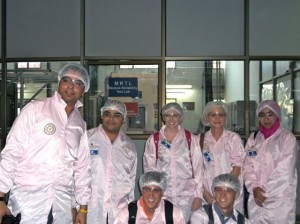On Thursday 07/26/ 2012 we had a visit to Fortis hospital in Bannerghatta Road, Bangalore. We were hosted at a conference room where we had an introduction about the hospital with a power point presentation. The speaker gave us general information about the hospital’s history and the business model which it follows as part of the Fortis health care system. Fortis Hospitals are among the biggest Indian Healthcare Networks in India and is been awarded a JCI accreditation which is the golden seal as far as clinical benchmarks are concerned globally. The speaker explained the business model of the hospital saying that it mainly focuses on medical tourism where expensive surgeries worldwide can be done in Fortis in a much lower price than in other places in the world. He stated that Fortis offers a high quality service compared to those offered in USA and Europe, yet in a very competitive price, making it the place of choice for patients who are not covered by insurance all over the world to have their expensive surgeries. In this context the speaker showed us a table of comparison of the costs of surgeries in Fortis vs the USA and many other centers for medical tourism in the world including Egypt and south Africa; the competitors. Fortis prices were much lower than any of the mentioned centers, according to the data in the presentation.
A video was displayed showing stories of many patients who were unable to afford the costs of surgeries in their own countries and were very much satisfied by the quality and costs of services in Fortis. The video featured patients from many places in the world such as USA, England, Germany.
According to the speaker, Fortis hospital is remarkable in surgery especially, orthopedic surgery like joints replacement, cardio surgery and neurosurgery, where the best and up to date prosthesis are used in such surgeries and that the quality of the used devices or implants is not negotiable even if the client wants cheaper prosthesis.
Also the speaker explained Fortis international marketing process, using web based tools like the Fortis web site, youtube, facebook and twitter. He also gave highlights on the service integrity and transparency with clients together with providing all services that the incoming traveler might need, starting from a handsome pick up at the air port up to designing a suitable touristic and entertainment program for the client during his/her stay in India.
The presentation also showed the inpatient suits and rooms where a luxurious quality of residency and service is offered to each client in 5 stars hotel fashion.
One of the impressive things said in this speech is that the Fortis hospital that we visited in Bangalore has four PET scan devices, which is absolutely rare to happen in one hospital, since that these devices are extremely expensive.
After this interesting presentation we were escorted by a guide for a tour in the different wards of the hospital. First we passed by the outpatient department where we saw the clinics that were very much organized and beautifully decorated. Then we passed fast by the emergency department, then the radiology department were we saw the CAT scan room, with the radiologist working on the sections taken. Finally we visited an empty patient room which was extremely luxurious, just like the rooms in the best five stars hotels.
It was a really nice experience and I really liked the hospital, that I can recommend it to anyone thinking of travelling abroad for medical treatment.
Ahmed Yassin
